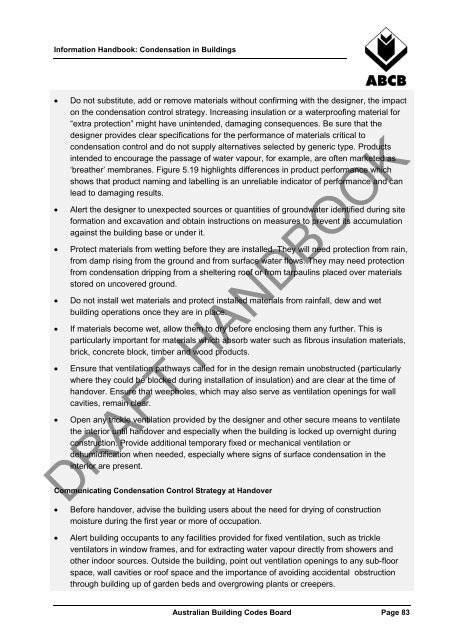Condensation in Buildings - Australian Building Codes Board
Condensation in Buildings - Australian Building Codes Board
Condensation in Buildings - Australian Building Codes Board
Create successful ePaper yourself
Turn your PDF publications into a flip-book with our unique Google optimized e-Paper software.
Information Handbook: <strong>Condensation</strong> <strong>in</strong> Build<strong>in</strong>gs<br />
• Do not substitute, add or remove materials without confirm<strong>in</strong>g with the designer, the impact<br />
on the condensation control strategy. Increas<strong>in</strong>g <strong>in</strong>sulation or a waterproof<strong>in</strong>g material for<br />
“extra protection” might have un<strong>in</strong>tended, damag<strong>in</strong>g consequences. Be sure that the<br />
designer provides clear specifications for the performance of materials critical to<br />
condensation control and do not supply alternatives selected by generic type. Products<br />
<strong>in</strong>tended to encourage the passage of water vapour, for example, are often marketed as<br />
‘breather’ membranes. Figure 5.19 highlights differences <strong>in</strong> product performance which<br />
shows that product nam<strong>in</strong>g and labell<strong>in</strong>g is an unreliable <strong>in</strong>dicator of performance and can<br />
lead to damag<strong>in</strong>g results.<br />
• Alert the designer to unexpected sources or quantities of groundwater identified dur<strong>in</strong>g site<br />
formation and excavation and obta<strong>in</strong> <strong>in</strong>structions on measures to prevent its accumulation<br />
aga<strong>in</strong>st the build<strong>in</strong>g base or under it.<br />
• Protect materials from wett<strong>in</strong>g before they are <strong>in</strong>stalled. They will need protection from ra<strong>in</strong>,<br />
from damp ris<strong>in</strong>g from the ground and from surface water flows. They may need protection<br />
from condensation dripp<strong>in</strong>g from a shelter<strong>in</strong>g roof or from tarpaul<strong>in</strong>s placed over materials<br />
stored on uncovered ground.<br />
• Do not <strong>in</strong>stall wet materials and protect <strong>in</strong>stalled materials from ra<strong>in</strong>fall, dew and wet<br />
build<strong>in</strong>g operations once they are <strong>in</strong> place.<br />
• If materials become wet, allow them to dry before enclos<strong>in</strong>g them any further. This is<br />
particularly important for materials which absorb water such as fibrous <strong>in</strong>sulation materials,<br />
brick, concrete block, timber and wood products.<br />
• Ensure that ventilation pathways called for <strong>in</strong> the design rema<strong>in</strong> unobstructed (particularly<br />
where they could be blocked dur<strong>in</strong>g <strong>in</strong>stallation of <strong>in</strong>sulation) and are clear at the time of<br />
handover. Ensure that weepholes, which may also serve as ventilation open<strong>in</strong>gs for wall<br />
cavities, rema<strong>in</strong> clear.<br />
• Open any trickle ventilation provided by the designer and other secure means to ventilate<br />
the <strong>in</strong>terior until handover and especially when the build<strong>in</strong>g is locked up overnight dur<strong>in</strong>g<br />
construction. Provide additional temporary fixed or mechanical ventilation or<br />
dehumidification when needed, especially where signs of surface condensation <strong>in</strong> the<br />
<strong>in</strong>terior are present.<br />
DRAFT HANDBOOK<br />
Communicat<strong>in</strong>g <strong>Condensation</strong> Control Strategy at Handover<br />
• Before handover, advise the build<strong>in</strong>g users about the need for dry<strong>in</strong>g of construction<br />
moisture dur<strong>in</strong>g the first year or more of occupation.<br />
• Alert build<strong>in</strong>g occupants to any facilities provided for fixed ventilation, such as trickle<br />
ventilators <strong>in</strong> w<strong>in</strong>dow frames, and for extract<strong>in</strong>g water vapour directly from showers and<br />
other <strong>in</strong>door sources. Outside the build<strong>in</strong>g, po<strong>in</strong>t out ventilation open<strong>in</strong>gs to any sub-floor<br />
space, wall cavities or roof space and the importance of avoid<strong>in</strong>g accidental obstruction<br />
through build<strong>in</strong>g up of garden beds and overgrow<strong>in</strong>g plants or creepers.<br />
<strong>Australian</strong> Build<strong>in</strong>g <strong>Codes</strong> <strong>Board</strong> Page 83
















